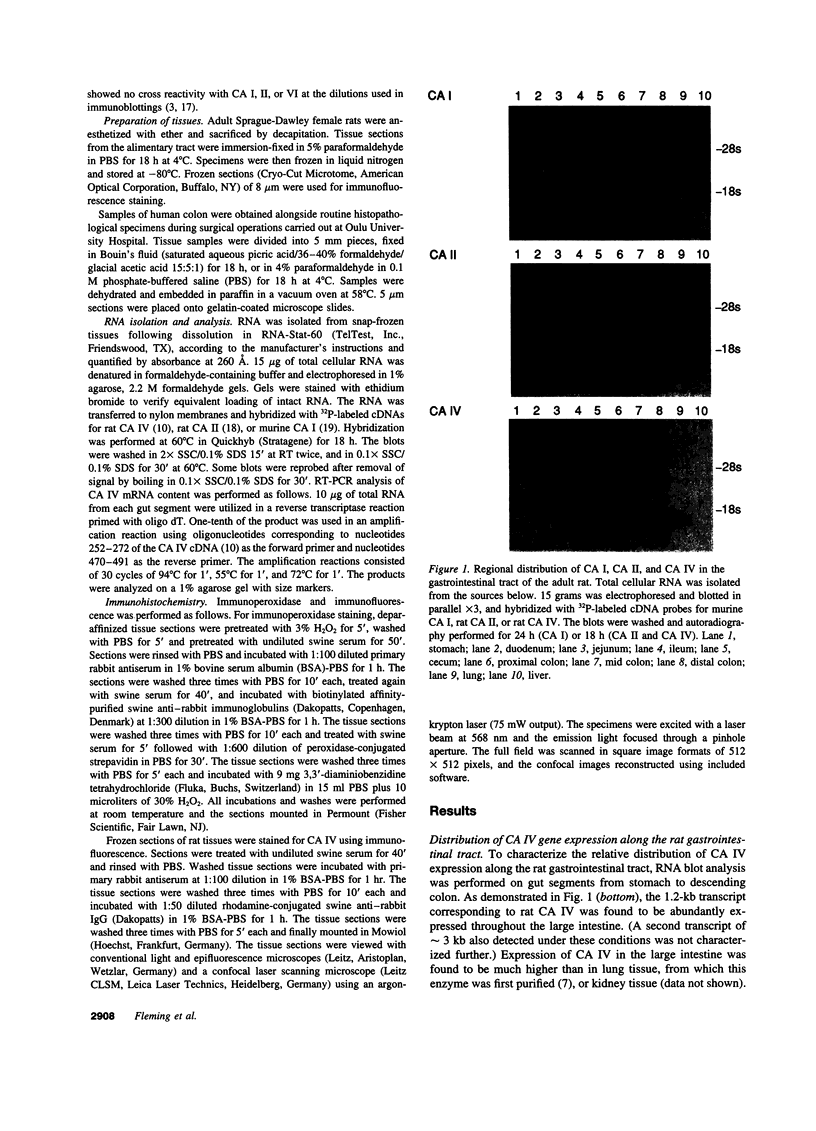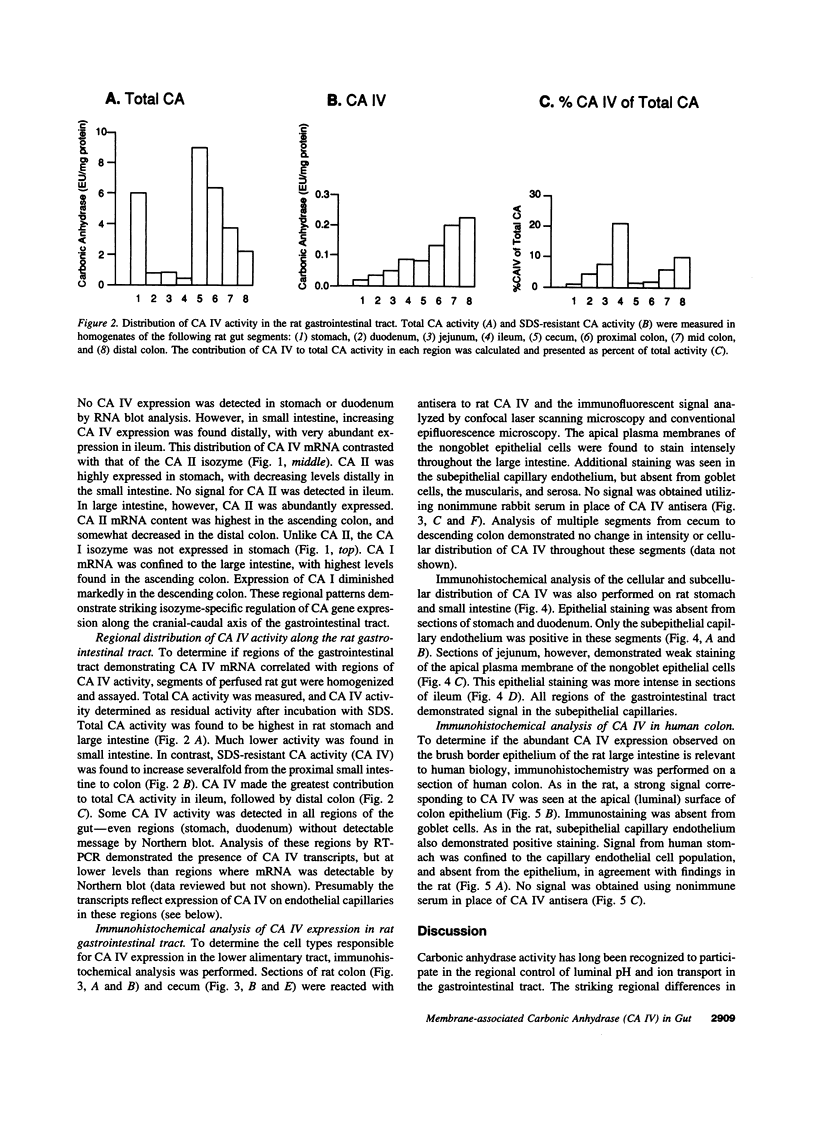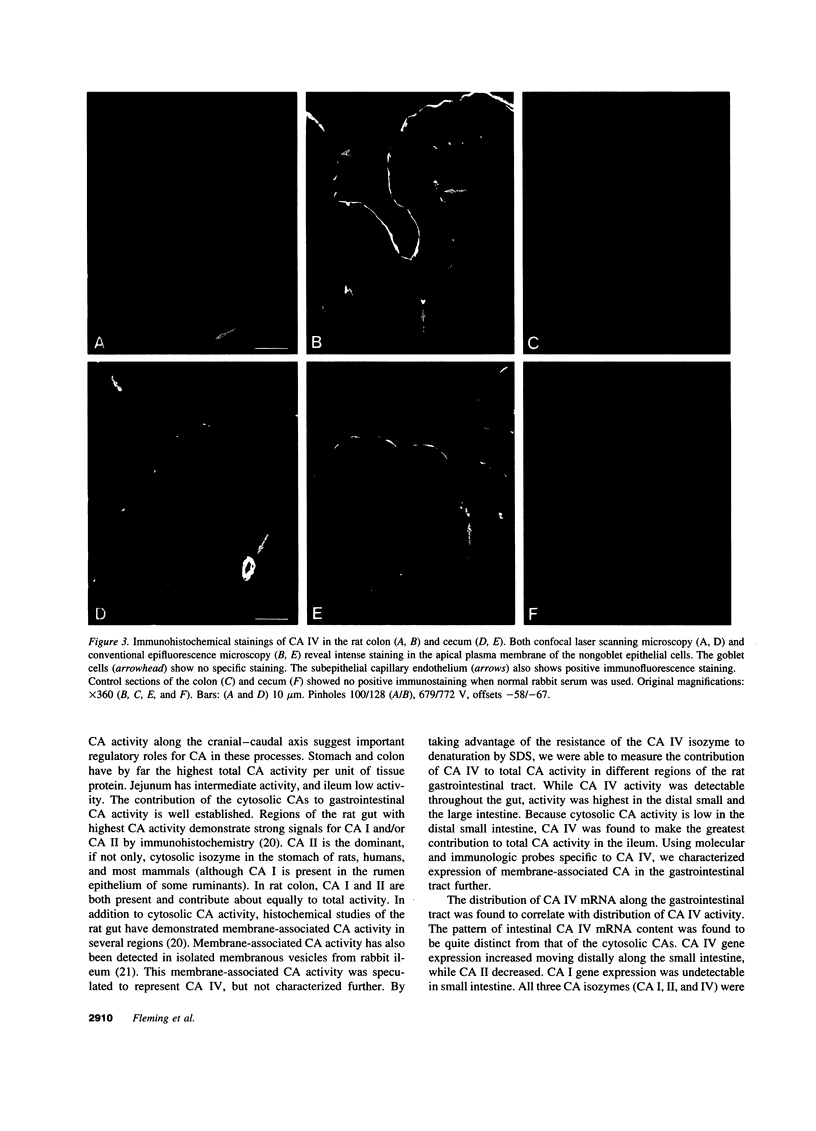Abstract
Carbonic anhydrase IV (CA IV) is a glycosylphosphatidylinositol-linked isozyme previously identified on the surface of renal tubular epithelium and certain populations of vascular endothelium. This report identifies the regional, cellular, and subcellular localization of CA IV in the rat gut. Northern blot and RT-PCR analyses demonstrated little CA IV expression in stomach or proximal small intestine, but abundant expression in distal small and large intestine. In contrast, CA II mRNA was abundant in stomach, decreased in proximal small intestine, low in distal small intestine, and abundant in large intestine. CA I mRNA was detected only in large intestine. The regional distribution of CA IV activity correlated with distribution of CA IV mRNA. Immunohistochemistry localized CA IV to the apical plasma membrane of the mucosal epithelium in distal small intestine and large intestine. Signal intensity was greatest in colon. CA IV was additionally found in submucosal capillary endothelium of all gastrointestinal regions. Immunohistochemical findings in human stomach and colon paralleled those in the rat. These studies demonstrate pre-translational isozyme-specific regulation of CA expression along the cranial-caudal axis of the gastrointestinal tract. The regional, cellular, and subcellular localizations are consistent with participation of CA IV in the extensive ion and fluid transport in the distal small and large intestine.
Full text
PDF






Images in this article
Selected References
These references are in PubMed. This may not be the complete list of references from this article.
- Aldred P., Fu P., Barrett G., Penschow J. D., Wright R. D., Coghlan J. P., Fernley R. T. Human secreted carbonic anhydrase: cDNA cloning, nucleotide sequence, and hybridization histochemistry. Biochemistry. 1991 Jan 15;30(2):569–575. doi: 10.1021/bi00216a035. [DOI] [PubMed] [Google Scholar]
- Argenzio R. A., Southworth M., Lowe J. E., Stevens C. E. Interrelationship of Na, HCO3, and volatile fatty acid transport by equine large intestine. Am J Physiol. 1977 Dec;233(6):E469–E478. doi: 10.1152/ajpendo.1977.233.6.E469. [DOI] [PubMed] [Google Scholar]
- Argenzio R. A., Whipp S. C. Inter-relationship of sodium, chloride, bicarbonate and acetate transport by the colon of the pig. J Physiol. 1979 Oct;295:365–381. doi: 10.1113/jphysiol.1979.sp012974. [DOI] [PMC free article] [PubMed] [Google Scholar]
- Binder H. J., Foster E. S., Budinger M. E., Hayslett J. P. Mechanism of electroneutral sodium chloride absorption in distal colon of the rat. Gastroenterology. 1987 Sep;93(3):449–455. doi: 10.1016/0016-5085(87)90905-x. [DOI] [PubMed] [Google Scholar]
- Brown D., Zhu X. L., Sly W. S. Localization of membrane-associated carbonic anhydrase type IV in kidney epithelial cells. Proc Natl Acad Sci U S A. 1990 Oct;87(19):7457–7461. doi: 10.1073/pnas.87.19.7457. [DOI] [PMC free article] [PubMed] [Google Scholar]
- Dagher P. C., Egnor R. W., Charney A. N. Effect of intracellular acidification on colonic NaCl absorption. Am J Physiol. 1993 Mar;264(3 Pt 1):G569–G575. doi: 10.1152/ajpgi.1993.264.3.G569. [DOI] [PubMed] [Google Scholar]
- Deutsch H. F. Carbonic anhydrases. Int J Biochem. 1987;19(2):101–113. doi: 10.1016/0020-711x(87)90320-x. [DOI] [PubMed] [Google Scholar]
- Effros R. M., Shapiro L., Silverman P. Carbonic anhydrase activity of rabbit lungs. J Appl Physiol Respir Environ Exerc Physiol. 1980 Oct;49(4):589–600. doi: 10.1152/jappl.1980.49.4.589. [DOI] [PubMed] [Google Scholar]
- Fleming R. E., Crouch E. C., Ruzicka C. A., Sly W. S. Pulmonary carbonic anhydrase IV: developmental regulation and cell-specific expression in the capillary endothelium. Am J Physiol. 1993 Dec;265(6 Pt 1):L627–L635. doi: 10.1152/ajplung.1993.265.6.L627. [DOI] [PubMed] [Google Scholar]
- Fraser P. J., Curtis P. J. Molecular evolution of the carbonic anhydrase genes: calculation of divergence time for mouse carbonic anhydrase I and II. J Mol Evol. 1986;23(4):294–299. doi: 10.1007/BF02100637. [DOI] [PubMed] [Google Scholar]
- Fraser P., Cummings P., Curtis P. The mouse carbonic anhydrase I gene contains two tissue-specific promoters. Mol Cell Biol. 1989 Aug;9(8):3308–3313. doi: 10.1128/mcb.9.8.3308. [DOI] [PMC free article] [PubMed] [Google Scholar]
- Geers C., Gros G., Gärtner A. Extracellular carbonic anhydrase of skeletal muscle associated with the sarcolemma. J Appl Physiol (1985) 1985 Aug;59(2):548–558. doi: 10.1152/jappl.1985.59.2.548. [DOI] [PubMed] [Google Scholar]
- Ghandour M. S., Langley O. K., Zhu X. L., Waheed A., Sly W. S. Carbonic anhydrase IV on brain capillary endothelial cells: a marker associated with the blood-brain barrier. Proc Natl Acad Sci U S A. 1992 Aug 1;89(15):6823–6827. doi: 10.1073/pnas.89.15.6823. [DOI] [PMC free article] [PubMed] [Google Scholar]
- Hageman G. S., Zhu X. L., Waheed A., Sly W. S. Localization of carbonic anhydrase IV in a specific capillary bed of the human eye. Proc Natl Acad Sci U S A. 1991 Apr 1;88(7):2716–2720. doi: 10.1073/pnas.88.7.2716. [DOI] [PMC free article] [PubMed] [Google Scholar]
- Heming T. A., Geers C., Gros G., Bidani A., Crandall E. D. Effects of dextran-bound inhibitors on carbonic anhydrase activity in isolated rat lungs. J Appl Physiol (1985) 1986 Nov;61(5):1849–1856. doi: 10.1152/jappl.1986.61.5.1849. [DOI] [PubMed] [Google Scholar]
- Knickelbein R., Aronson P. S., Schron C. M., Seifter J., Dobbins J. W. Sodium and chloride transport across rabbit ileal brush border. II. Evidence for Cl-HCO3 exchange and mechanism of coupling. Am J Physiol. 1985 Aug;249(2 Pt 1):G236–G245. doi: 10.1152/ajpgi.1985.249.2.G236. [DOI] [PubMed] [Google Scholar]
- Lönnerholm G., Selking O., Wistrand P. J. Amount and distribution of carbonic anhydrases CA I and CA II in the gastrointestinal tract. Gastroenterology. 1985 May;88(5 Pt 1):1151–1161. doi: 10.1016/s0016-5085(85)80074-3. [DOI] [PubMed] [Google Scholar]
- MAREN T. H. A simplified micromethod for the determination of carbonic anhydrase and its inhibitors. J Pharmacol Exp Ther. 1960 Sep;130:26–29. [PubMed] [Google Scholar]
- Murakami H., Sly W. S. Purification and characterization of human salivary carbonic anhydrase. J Biol Chem. 1987 Jan 25;262(3):1382–1388. [PubMed] [Google Scholar]
- Parkkila S., Parkkila A. K., Kaunisto K., Waheed A., Sly W. S., Rajaniemi H. Location of a membrane-bound carbonic anhydrase isoenzyme (CA IV) in the human male reproductive tract. J Histochem Cytochem. 1993 May;41(5):751–757. doi: 10.1177/41.5.8468457. [DOI] [PubMed] [Google Scholar]
- Peterson G. L. A simplification of the protein assay method of Lowry et al. which is more generally applicable. Anal Biochem. 1977 Dec;83(2):346–356. doi: 10.1016/0003-2697(77)90043-4. [DOI] [PubMed] [Google Scholar]
- Ruppin H., Bar-Meir S., Soergel K. H., Wood C. M., Schmitt M. G., Jr Absorption of short-chain fatty acids by the colon. Gastroenterology. 1980 Jun;78(6):1500–1507. [PubMed] [Google Scholar]
- Sly W. S., Hewett-Emmett D., Whyte M. P., Yu Y. S., Tashian R. E. Carbonic anhydrase II deficiency identified as the primary defect in the autosomal recessive syndrome of osteopetrosis with renal tubular acidosis and cerebral calcification. Proc Natl Acad Sci U S A. 1983 May;80(9):2752–2756. doi: 10.1073/pnas.80.9.2752. [DOI] [PMC free article] [PubMed] [Google Scholar]
- Stolle C. A., McGowan M. H., Heim R. A., Varia M., Neubauer J. A. Nucleotide sequence of a cDNA encoding rat brain carbonic anhydrase II and its deduced amino acid sequence. Gene. 1991 Dec 30;109(2):265–267. doi: 10.1016/0378-1119(91)90619-m. [DOI] [PubMed] [Google Scholar]
- Sundaram V., Rumbolo P., Grubb J., Strisciuglio P., Sly W. S. Carbonic anhydrase II deficiency: diagnosis and carrier detection using differential enzyme inhibition and inactivation. Am J Hum Genet. 1986 Feb;38(2):125–136. [PMC free article] [PubMed] [Google Scholar]
- Tashian R. E. The carbonic anhydrases: widening perspectives on their evolution, expression and function. Bioessays. 1989 Jun;10(6):186–192. doi: 10.1002/bies.950100603. [DOI] [PubMed] [Google Scholar]
- Turnberg L. A., Bieberdorf F. A., Morawski S. G., Fordtran J. S. Interrelationships of chloride, bicarbonate, sodium, and hydrogen transport in the human ileum. J Clin Invest. 1970 Mar;49(3):557–567. doi: 10.1172/JCI106266. [DOI] [PMC free article] [PubMed] [Google Scholar]
- Waheed A., Zhu X. L., Sly W. S. Membrane-associated carbonic anhydrase from rat lung. Purification, characterization, tissue distribution, and comparison with carbonic anhydrase IVs of other mammals. J Biol Chem. 1992 Feb 15;267(5):3308–3311. [PubMed] [Google Scholar]
- Waheed A., Zhu X. L., Sly W. S., Wetzel P., Gros G. Rat skeletal muscle membrane associated carbonic anhydrase is 39-kDa, glycosylated, GPI-anchored CA IV. Arch Biochem Biophys. 1992 May 1;294(2):550–556. doi: 10.1016/0003-9861(92)90724-b. [DOI] [PubMed] [Google Scholar]
- Whitney P. L., Briggle T. V. Membrane-associated carbonic anhydrase purified from bovine lung. J Biol Chem. 1982 Oct 25;257(20):12056–12059. [PubMed] [Google Scholar]
- Wistrand P. J., Knuuttila K. G. Renal membrane-bound carbonic anhydrase. Purification and properties. Kidney Int. 1989 Mar;35(3):851–859. doi: 10.1038/ki.1989.63. [DOI] [PubMed] [Google Scholar]
- Zhu X. L., Sly W. S. Carbonic anhydrase IV from human lung. Purification, characterization, and comparison with membrane carbonic anhydrase from human kidney. J Biol Chem. 1990 May 25;265(15):8795–8801. [PubMed] [Google Scholar]






